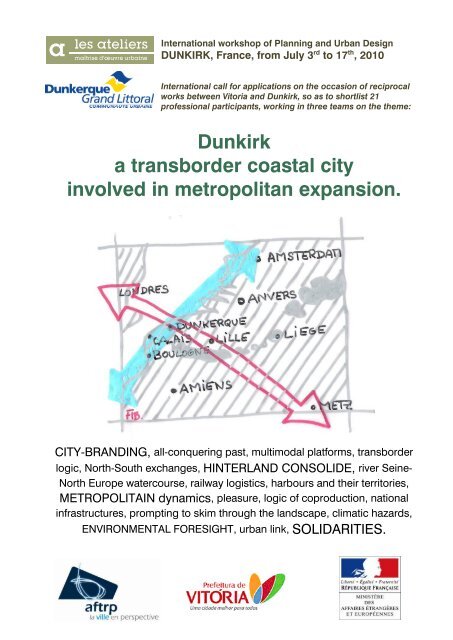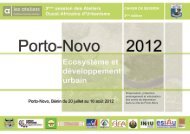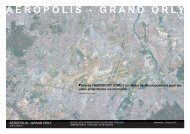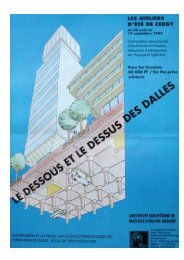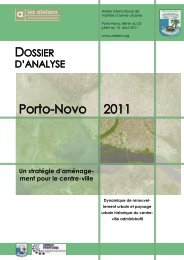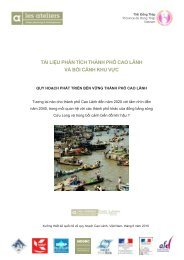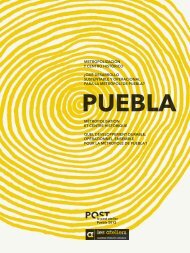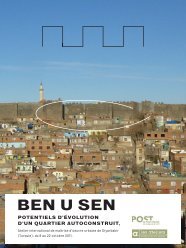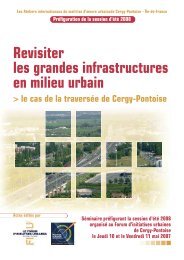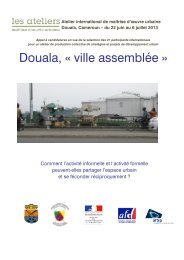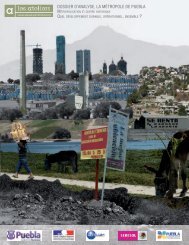Topic document pdf 3 Mb - Les Ateliers
Topic document pdf 3 Mb - Les Ateliers
Topic document pdf 3 Mb - Les Ateliers
- No tags were found...
You also want an ePaper? Increase the reach of your titles
YUMPU automatically turns print PDFs into web optimized ePapers that Google loves.
International workshop of Planning and Urban DesignDUNKIRK, France, from July 3 rd to 17 th , 2010International call for applications on the occasion of reciprocalworks between Vitoria and Dunkirk, so as to shortlist 21professional participants, working in three teams on the theme:Dunkirka transborder coastal cityinvolved in metropolitan expansion.CITY-BRANDING, all-conquering past, multimodal platforms, transborderlogic, North-South exchanges, HINTERLAND CONSOLIDE, river Seine-North Europe watercourse, railway logistics, harbours and their territories,METROPOLITAIN dynamics, pleasure, logic of coproduction, nationalinfrastructures, prompting to skim through the landscape, climatic hazards,ENVIRONMENTAL FORESIGHT, urban link, SOLIDARITIES.Presentation of the workgroup “Dunkirk, a transborder maritime city” -– July 2010 – contact@ateliers.org 1
PREAMBULEIn 2008, the President of the urban community in Dunkirk, France and Vitoria’smayor in Brazil, have called upon the French association «<strong>Les</strong> <strong>Ateliers</strong> -International Workshops of Planning and Urban Design» to schedule a doublesession based on the theme of regional solidarities and urban development. Afirst session occurred on that occasion in Vitoria, Brazil at the fall 2009, and wasfollowed by a participation in the worldwide urban forum held in Rio in March2010. The second one will be held this summer in Dunkirk, in the logic of theconsiderations carried out on the theme of a balanced development for harbourcities and their future, especially in the perspective of harbour economicevolution, initiating wealth and unsteadiness on the territoryThe synergies Harbour-City, triggering off local wealth, indeed scope a widerange of investigations to be explored in more qualitative perspectives :international business relationships, cultural exchanges, migratory phenomena,synergy with the hinterland (territory of mining passageways located in themetropolis of Lille), the maritime imaginary….This <strong>document</strong> introduces the subject of the atelier. It is sent to our partners as well as to the whole internationalnetwork of <strong>Les</strong> <strong>Ateliers</strong>, in order to summon applications from professionals.Writing: Florence Bougnoux, architect-urbanist, pilote of the workshop, on the basis of previous oral exchangesand written notes, which were then drafted regarding the preparatory mission in February and March 2009,carried out by:1) <strong>Ateliers</strong> members: Jean-Michel Guénod, Nicolas Samsoen, Christian Horn, and Nicolas Détrie, director.2) Dunkirk Urban Community’s (CUD) follow-up committee composed of the Urban Development Head Office,the economic development and inland attraction Head Office, the strategy Head Office, European and worldwidepartnerships created hand in hand between the city of Dunkirk and its town-planning department. Some parts ofthe <strong>document</strong> have been directly written by CUD.Rereading and page setting: Nicolas DétrieThis <strong>document</strong> exists in different versions: French, English and Portuguese. A free-access download is alsoavailable at: www.ateliers.orgIssued on April 6 th 2010Presentation of the workgroup urban project management in Cergy-Pontoise, France.les ateliers is a non-governmental organization that gathers universities, decision makers and professionals dedicatedto planning, development and urban design. Since 1982, les ateliers has been organizing international workshops ontopics defined together with local authorities for city or regional planning. The method consists in gathering studentsor professionals of different nationalities and different specializations (landscape designers, architects, engineers,economists...), and make them work in different teams that finally present their proposals to an international jurycomposed of local authorities and international experts. Each workshop offers to local authorities new and innovativeurban development proposals, assessed by the members of the jury and transcribed into a synthesis delivered 2months after the workshop. These workshops are also a source of training for all the participants, whether they belocal or international experts. At the beginning, les ateliers focused on planning issues for the Paris Ile de FranceRegion. Then, they developed a very high knowledge in Asia (we held 10 workshops there: Tokyo, Doi Tung, Canton,Shanghai, Ho Chi Minh, An Giang, Can Gio, Phnom Penh, Bangkok) and recently diversified their fruitful workcombining workshops along the Mediterranean Sea (Casablanca, Marseille and Alexandria of Egypt) and in Africa andSouth America (Benin, Senegal and Brasil).Presentation of the workgroup “Dunkirk, a transborder maritime city” -– July 2010 – contact@ateliers.org 2
SUMMARY1- Introductive forewordDunkirk on the international world stage.Dunkirk at the crossroads of a transborder coastal axis and a promoted hinterland.2- Contexta. Economic and industrialThe sea, economic resource and driving force of the economy in Dunkirk.Sports, leisure and health.b. Historical and geopolitical contextDunkirk, a territory won over sea.Port life, economic boom, the mining passageway and the 2 worldwide conflictsc. UrbanInfrastructures and networks.Dunkirk hacked by state sectors: cities parcelled out by infrastructuresUnbalanced territoriesd. Environmentale. Social and culturalDunkirk, a land of solidarity to face challengesf. Administrative and institutional contexts: governance in DunkirkAn articulation of territorial logicsAn over-determined territory as for strategy3- The topic of the atelierThe paradoxs of this territory : A state-decided, source of discrepancy.The end of the “supply cycle “The workshop expectancies : What happens next? “Dunkirk 2.0” Interlocking scales and issues.4- How to participateProvisional schedulePresentation of the workgroup “Dunkirk, a transborder maritime city” -– July 2010 – contact@ateliers.org 3
1- Introductive forewordDunkirk on an international perspectiveThough the debate on the project « Grand Paris » has given a new perspective to the marine frontage thanks tothe cities of Rouen and Le Havre, a wider north-east marine frontage appears likely to be tackled on aninternational scale. It faces England, designs the banks of a diabolo and marks the boundary of the insula ofCotentin in the south, the island of the Frise in the north, Dunkirk being located at the very centre of this widescopenetwork, 1’30 hour from the most important maritime passageway, in the north of the French territoryand in the south of northern Europe situated in the centre the Triangle London-Brussels-Paris.In this competitive context linked to port and post-industrial economy, Dunkirk has remained in a pivotalsituation and has developed a synergy with Vitoria, a booming Brazilian harbour located northern Sao Pauloand Rio, and beyond economic matters, Dunkirk has tackled the issue of territorial solidarities, on a Franco-Belgian transborder maritime axis, as well as the relationship between land and sea to be straightened with thecity of Lille, London, Brussels and Paris, therefore promoting the Hinterland development.CalaisLillePresentation of the workgroup “Dunkirk, a transborder maritime city” -– July 2010 – contact@ateliers.org 4
Dunkirk at the crossroads of a transborder maritime axis anda promoted hinterlandThough Dunkirk is located at the very centre of a world scale prosperitytriangle, it paradoxically and noticeably appears lagging behindneighbouring territorial dynamics.Two incompletely-detailed themes are reported: Socio-economic: How to escape “the storm centre“?Beyond the tracks linked to local assets (beach and wind,Thalassotherapy, Côte d’Azur of Eastern Europe…), Entrepreneurial: How to set up a real dynamism of investments in thecity? Would it be worth being on the look-out somewhere else?The participants will endeavour to find out harbour logisticaltracks (the battle of harbours has to be won ashore), agree tocomplement the cities of BOULOGNE and CALAIS (regionalharbour) and to act jointly with channels and railways.Besides, having a short-term viewpoint, how to perpetuate the“excess“ related to the Olympic Games in London, as a catalystfor energy?Nonetheless, the international city of Dunkirk nowadays needsto reattach to its hinterland, spatially speaking as well as on theeconomic and social level.Dunkirk develops various cooperations on a transborder andinternational level, yet such an extensive outlook is limited to institutions and does not target either thepopulation or the territory that would deserve to be questioned in this federative revitalized project. What arethe necessary driving forces leading to a new broadening development, revitalizing the city resources andthose of the territory?Various tracks can actually be explored, in a logic by which the city-centre has to be pepped up and mademore attractive, in accordance with current functions, relevant perimeters to question, and anticipatinginfrastructure projects planned on the long run.How could the northern seacoast of France become the northern Europe “Côte d’Azur “and benefit from theattraction of seacoasts (which is not currently the case of the French North-West quadrant)?How can this seacoast be attached to both close and far-off, rural and economic hinterland: the Flanders atless than half an hour from it, Lille, Dourges and <strong>Les</strong>quin (hardly one hour), or even England and the cities ofthe so-called “blue banana” - Brussels, Antwerp, Rotterdam – served by ecological means of transportationsuch as the railways or the channel river Seine-North Europe?How to turn the image of a coast dedicated to the industry into a coast bathing in pleasure, health andsustainable development and regain residential attraction? How to turn from a centralized to anentrepreneurial economy? How to connect everything despite a historically and spatially divided andscattered territory?How to anticipate the consequences of global warming and Dunkirk’s adaptation to a possible rise in thewater level?Presentation of the workgroup “Dunkirk, a transborder maritime city” -– July 2010 – contact@ateliers.org 5
2a- Economic and industrial contextThe sea as an economic resource, driving force of theeconomy in DunkirkHarbour economy (sea and land: what hinterland, what necessary means, whatnetworks?) “The battle of harbours has to be won ashore. “Dunkirk took advantage of an important growth during the industrial era, as a communication gateway ofthe mining passageway, Dunkirk is nowadays the third harbour in France, then comes Le Havre andMarseille, 6th European harbour ; southern gateway of the North Sea (most attractive strait in the world).It is located on the coast Channel-North Sea, which is one of the most concentrated in the world: 800kilometres from the Havre to Hamburg, sharing 1200 Mt (number dated 2008), to be confronted with theMediterranean frontage, the global traffic of which has been inferior to 700 Mt the same year.Dunkerque Lille AmsterdamMMap of navigable waterways in EuropeHowever, this traffic is unequally shared between the harbours neighbouring the Channel-North Sea,Rotterdam and Antwerp, for they benefit from a vast hinterland through a direct accessibility to thenavigable network of the rivers Rhine and Danube. The harbours already share half of this traffic(Rotterdam, 4th harbour in the world provides itself 421 Mt in 2008 and Antwerp, 15th harbour in theworld, 189 Mt in 2008).Presentation of the workgroup “Dunkirk, a transborder maritime city” -– July 2010 – contact@ateliers.org 6
Dunkirk’s harbour indeed takes advantage of a favoured place on the maritime frontage, being locatedextremely next to the most important worldwide maritime passageway (less than 1 hour and a half). It islinked to England and the suburbs of Paris by high-performance railway (freight and passengers: cf.railway chrono-distance map vs. Road at the end of the <strong>document</strong>) as well as Lille and its miningpassageway (railway and waterway first created during the industrial era (cf. historical context). Anothermajor asset is the vast accommodation capacity of logistical and industrial installations (3,000 acres ofland available over 7,000 acres devoted to business parks).Assets or liabilities of channel Seine-Northern Europe?Regarding the competition between French harbours, how will Dunkirk take advantage of the widenedconnection to the suburbs of Paris through the channel Seine-Northern Europe? In addition, consideringthe competition with Belgian and Dutch harbours, how will Dunkirk manage to take a stand so as toavoid that the so-called channel, works as a “GDP vacuum cleaner “ of the suburbs of Paris bydisservicing habours of Antwerp, Rotterdam and Hamburg?Railway service: a major asset with regard to the East-West railway passagewayRailway service has nowadays become one of the assets emphasized and obviously maintained byDunkirk’s harbour, 1st French railway harbour: 51.5% of the traffic is carried out via railways and only11% via navigable waterways. In order to enable to increase and strengthen the preeminence of railway,and so as to get parts of the traffic from the important railway passageways – while improving localservicing – studies have been led to discuss the electrification of the axis Calais-Dunkirk, to put the axisDunkirk-Adinkerque again into service for travelers (and to a greater extent, Muizen and Antwerp). A newtrack for freight towards Belgium could also enable to develop a transborder railway axis, on a local andinternational scale.Deploying a digital networkThe urban community of Dunkirk has been willing to set up a voluntary policy inherent to the « digitaldevelopment » of its territory. Anxious to provide its territory with all the necessary assets to keep andimplement new economic activities, the CUD made the choice to create a Telecom setup with fibre-opticcable over a vast perimeter. This political will, materialized at the beginning of 2009 for a serviceagreement, was signed with the firm DGL Network (subsidiary of COVAGE, belonging itself to VinciPresentation of the workgroup “Dunkirk, a transborder maritime city” -– July 2010 – contact@ateliers.org 7
Networks and Axia). The aim of the delegation is to design, build and operate a long network of 170kilometers, engineered to meet the needs of firms, public administrations and individuals. Law haseffectively permitted local authorities to practice the activity of telecom operator since 2004 by setting-upinfrastructures that have to be “neutral, open and possible to mutualize”.Thus, launched in the beginning of 2009, the network made by DGL Networks will be able to serve 45business parks, 5 accommodations for companies and 300 sites belonging to public services over thewhole city for the summer 2010. The implementation of this policy aims at promoting the arrival of newservice providers by sparing them the burden of the conception and deployment of their own telecomnetwork. Though this, the CUD wishes to enable firms and administrations to get access to services thatwere so far insufficiently developed, such as hosting websites, the voice on IP, video and Visioconference, very high-speed access to the Internet, and VPN (virtual private network).The sea as a well-being resource: sports, leisure and health.The connection with the sea in collective representations is not dealtwith in the <strong>document</strong>, as is the case in most of seaside resorts, as areal alternative regarding pleasure and touristic destinations, on aneconomic scale: Dunkirk’s beach is not to be a place for leisure, thesame goes for Belgian beaches or those located on the Côted’Opale. However, natural spaces bordered by dunes as well as theeastern part of the city’s seashore are particularly preserved andbrought out par associations and regional authorities. Besides, sincethey are wind-exposed, these spaces offer quality spots for surfingand sailing addicts and for the locals who foster a peculiar relation to work and effort. That is the way thecity counts a vast number of Olympic champions and sport is usually practised on the occasion ofcompetitions. What is here at stake is to position the sea as a source of energy for human beings and theterritory: producer of energy, being alternative or fossil, place of cultural intermingling and worldwideopening, resource of the functional rehabilitation…Dunkirk’s position regarding high-level environmental qualityAt the heart of France and European industry, Dunkirk has revealed its will to combine industry andenvironment. Dunkirk thus appears among the precursors as far as industrial ecology is concerned. Theimplantation of steel industry in the sixties, then the creation of a platform linked to industrial and portactivities have very rapidly precipitated people locally involved into a definition of the exemplary industrialproject with regard to the respect of environment, wage earners and populations. It is transposed by thecreation of tools and the implementation of various means (diversification, training and promotion):creation of an exploration site and transfer of technologies in partnership with the university and theindustrial groups, creation of a permanent Office in charge of the Prevention of Industrial Pollutions. Butthis is particularly the elaboration of an Industrial Environmental Chart in 1993 which conveys such aconciliation industry/environment and the pursuit of excellence. This partnership planning <strong>document</strong>resulting from a necessity for the city and the needs of industry is more the outcome of cooperationbetween public authorities and private manufacturers than a unilateral regulation.Energy: centres of energiesWith a particular concern for this research of environmental high quality, Dunkirk has become one of themajor European energetic platforms. Every sort of energy is represented on Dunkirk’s territory: nuclear (1stEuropean nuclear power plant), fossil (oil workstations, oil refinery, gas pipelines, coal…), Aeolian windmill,thermal (plant of thermal production). It is also the variety of activities which makes Dunkirk rank amongEuropean energetic platforms: production, consumption, transformation and importation: centre of energeticpromotion of Dunkirk’s urban community (55GWh a year), urban heating network through the recovery ofunavoidable industrial heat, soiled-inserted gas pipeline (16 billion cubic meters a year), project to build a gasburner station, fuel cell under experimentation…Presentation of the workgroup “Dunkirk, a transborder maritime city” -– July 2010 – contact@ateliers.org 8
Dunkirk, a tense job marketThis energetic and industrial situation staunchly strikes Dunkirk’s job market and economic network. Dunkirktherefore takes the best of it through a huge wage system – mainly thanks to men – and an importantdependency to big international groups that intervene in the harbour sectors, steel industry, chemistry or foodindustry. Temporary work concerns almost half of the wage earners in the firms providing services.This structuring industrial context presents as manyassets as vulnerable sources for the territory: tensionsbetween the job offer market and the availableworkforce, tensions between the offer about training andthe job market. The unemployment rate testifies thesituation by coming close to 12.7% (slightly inferior tothe average of the region Nord Pas de Calais) while ithardly reaches 6% in some districts of western Flandersin Belgium. Among the job seekers, women and youngpeople from Dunkirk are particularly touched byunemployment. Precarious situations affect morewomen than men. Here is the reason why a struggle Employment rate on both sides of the borderagainst work exclusion has become a major concern inDunkirk. It is difficult to have a precise overview of the people on the verge of re-entering the job market.Yet, the proportion of women as well as the percentage linked to hiring, in insertion workgroups, isexceptionally high in Dunkirk’s vicinity, compared with Nord-Pas-de-Calais.Regarding job creation, the service sector constitutes the major source of job creations. Public structuresoccupy a prominent place among the most important employers in Dunkirk (the general hospital,Dunkirk town centre and the CUD). But the reform of local tax is going to radically modify this economicmodel. If creating one’s own has not already become customary and popular in Dunkirk, the currentdemographic evolutions (the population getting older, feminization of the working force…) triggersopportunities to be picked up. In effect, the sector of personal caring services could be particularlydynamic in Dunkirk’s labour pool. The transfer of companies is also part of these opportunities (in thesectors of trade, car mending and domestic items). The management of social and solidarity-orientedorganizations supported by public institutions also represents a leverage to be taken into account todevelop entrepreneurship.Malo BeachPresentation of the workgroup “Dunkirk, a transborder maritime city” -– July 2010 – contact@ateliers.org 9
2b- Geopolitical and historical contextDunkirk, a territory won over the seaAround the seventh century, Dunkirk emerged in the form of a fishing organization which settled on thebank of a small cove sheltered by dunes. From that moment on, the locals built the first chapel that leftits name to the locality: dunes’ church (Duyn Kerke in Flemish). Marshy lands in the eleventh century,human polderization developed thanks to cloistered institutions. That period enabled the territory toorganise through a maritime and agricultural frontage, leaving geographical layouts that are still apparentsuch as the stabilized cord made of dunes, Aa’s bank, a very meshed water system, pumps and outletchannels permitting to the land to be cultivated.(CAUE Source Map of northern Europe) Dunkerque Lille Amsterdamdelta de l’AaAudomaroisMonts de Flandres(Mont-Cassel)Vallée de la LysMap of fortified cities-Lock of Mardyck and of Mardyck’s channel before restorationVallée de l’EscautPresentation of the workgroup “Dunkirk, a transborder maritime city” -– July 2010 – contact@ateliers.org 10
Mainly fishing harbour until the first half of the fourteenth century, Dunkirk’s harbour rapidly developed anactivity revolving around massive import and export [(the Netherlands (cervoise), European northerncountries (wood), iron from Sweden, wine from Bordeaux)] and the belfry was testimonial of it all.Dunkirk very rapidly became the home port for privateers at the service of Spain, in a country in the gripof wars between England, France, Holland and Spain. Raking the seas, the population from Dunkirkquickly forged a reputation on the maritime history the city would remain based on. Lusted after by greatpowers, a remarkable amount of suzerains succeeded one another: Flemish, Burgundians, Austrians,Spaniards, English and French. Ultimately French in 1662, the city made the most of the period of respitethanks to Louis XIV’s interest, a radical transformation which would rank it at the same level than otherbig cities of the kingdom.In the seventeenth century, Vauban bought Dunkirk’s harbour back from the English, endowed it with aboard of trade in 1700 and a citadel, strengthening it as an outer military and commercial harbourwithin its network of fortified cities. Flanders’ coastal cities on both sides of the current border (Calais,Gravelines, Petite Synthe, Mardyck, Dunkirk, Bergues, and Ypres…strongholds or fortified citiessurrounded by gaps) were consequently fortified.Map by CassiniA port life submitted to political hazardsIn the eighteenth century, Louis XIV allowed the digging of Mardyck’s channel, fated to become asubstitute harbour linked to the sea through “the most beautiful lock in Europe “, but the internationaldiplomatic agreements of The Hague entailed a destruction of Dunkirk’s stronghold. Louis XVI restoredDunkirk’s harbour activities and confirmed the exemptions and privileges granted to the harbour inMarch 1784. It actually permitted to revive the trading activities of the harbour.Presentation of the workgroup “Dunkirk, a transborder maritime city” -– July 2010 – contact@ateliers.org 11
Map of the cities with fortifications (source: Architectural, Planning and Environmental Council - in department Nord)The economic boomThe eighteenth century revealed less favorable for the Flemish harbour, except considering thedevelopment of cod fishing in Iceland which would permit occupying the national first rank in thenineteenth century. In the beginning of the nineteenth century, Napoleon I neglected Dunkirk but placeda bet on Antwerp that had become a French city, after being conquered. The harbour was indeed in badcondition. The downfall of the Empire and the sequentially loss of Antwerp by France, soon gave a newstart to Dunkirk’s harbour. In 1848, the arrival of the railway in Dunkirk was decisive and followed bysignificant heavy work regarding the future of the harbour thanks to the digging of the western harbour,simultaneously causing the first seaside resort to vanish. In 1868, Dunkirk’s seaside resort funded acasino, a convention centre (Kursaal), hotels, a seawall and beach huts. In accordance with PlanFreycinet, harbour basins were built. Finally, in 1879 a radical transformation of the harbour was underway and it would permit to compete with its neighbors and to become the main way leading to the NorthSea in the country.Dunkirk on the threshold of the mining passagewayIn 1891, Dunkirk at last became the 3rd French harbour thanks to its commercial impulse. At the end ofthe nineteenth century, Dunkirk was the way out of the mining passageway, interfacing with maritimelinks and the exploration of iron ore, and progressively of manufactured goods (metalworking industryand steel industry) from the ironworks located in Denain (1834), Anzin(1849), Trith saint-Léger(1911),and eventually Dunkirk-Mardyck(1956), Dunkirk’s harbour having a significant role in the development ofthe steel industry in Nord Pas de Calais, contrary to the Lorrain basin, not properly connected to theinfrastructures. In fact, important infrastructures, the channel linking Dunkirk-Denain-Valenciennes andthe railway Valenciennes-Thionville, strengthened the attraction of Nord-Pas de Calais to the detriment ofthe Lorrain basin. The same went for the suburbs of Dunkirk to the detriment of suburban Valenciennes.Presentation of the workgroup “Dunkirk, a transborder maritime city” -– July 2010 – contact@ateliers.org 12
Map of the mining passageway (source: Architectural, Planning and Environmental Council - in department Nord)Dunkirk bombed out during the two worldwide conflicts1914: World War I broke out. Dunkirk is under siege. The city was ready for war and the hinterlandpodlers are once more flooded, by the way 7,000 acres were used as a “preventive flood “ from August1914 to May 1915. The German army, aware of its essential role, severely bombed Dunkirk. Thepopulation remaining in the city is involved in National Defense; dockyards launched the biggestfreighter of the French fleet. Dunkirk is very active regarding its role as a backfront city: the harbourenabled to receive supplies for the forefront. At that stage of the war, 20,000 soldiers of all ally nationspassed through Dunkirk.During World War II in June 1940, the French and English armies found themselves surrounded inDunkirk. One of the most tremendous evacuation operations in the military history, operation “Dynamo “permitted to bring more than 300,000 Englishmen and 100,000 French back to Great-Britain. In theaftermath of the war, more than 70% of Dunkirik was destroyed because of the bombing from theGerman nation and the allies. The harbour had remained inaccessible until June 1646. The rebuilding ofthe urban network was carried out by Théodore Leveau.The architect Jean Niermans would be in charge of housing rebuilding (red islets). In the area of “Glacis“, hundreds of American cabins would be built and were still inhabited in the beginning of the seventies.In 1957, the steel group Usinor decided to implement a steel production plant. Following its opening in1963, the city very rapidly increased from 70,000 to 200,000 inhabitants.Dunkirk became a major industrial city. Since 1989, just after the closing down the French shipyards, thecity as well as the Dunkirk Urban Community have involved in a wide-scope urban project aiming atreconquering wild lands: Neptune project.Those periods of destruction and reconquest have effectively built-up the territory’s urban shapes andthe relation individual-territory.Presentation of the workgroup “Dunkirk, a transborder maritime city” -– July 2010 – contact@ateliers.org 13
2c- Urban contextInfrastructures and networksWater system networks, anti-urban highway and the harbour, all constitute disconnections administeredby state organizations, isolating each city from its neighbouring one. As a consequence, it appears thatthe Urban Community is the most relevant to support a federative project repeated to the State and istherefore able to make good use of the skills related to these fields, which actually divide the territoryinstead of taking its control. In this perspective, the scale of the pedestrian does not exist outsideDunkirk city centre and still, cars remain prominent because of the difficulty to shift from one enclave toanother one - traditional house estate, council housing and companies – and to get over “nationalnetworks” - highways, speedway, channels, waterways – without leaving aside northern Europeanclimatic conditions. Everything thus compels to use the car despite a developed, yet under-achieved busnetwork because the latter serves a vast territory devoid of significant centers. How to value theseinfrastructures for a new future and a new perception of the territory?It will be necessary to consider the evolution of this territory with regard to scheduled infrastructures(deviation towards the south of A16 and extension of the western harbour to the south, in the direction ofBourbourg- Port sec, and the multimodal area). It will besides be important to integratetelecommunications as network infrastructures and to consider them in the urban project. The recentdecision taken by CUD to engage in the construction of a metropolitan network results in a politicalvision about these networks’ economic and spatial roles.Presentation of the workgroup “Dunkirk, a transborder maritime city” -– July 2010 – contact@ateliers.org 14
Cities composed of juxtaposed enclaves: industrial zones,housing estate and huge blocks of Council housingThis city which has endlessly been rebuilt by highly identifiable sectors – yet divided by networks –results in juxtaposed urban logics. The architects and their backers marked the territory to such an extentthat it has become easy to recognize the district of the city in which you are. “A deeply-rooted identity” aswell as unmarked fragmented zoning devoid of «cachet » are evidently missing in Dunkirk.The different stages of urbanization and industrial transformation have indeed been made clear,distinguishing sectors of projects : working-class garden cities in the twenties in Saint-Pol sur mer,seaside housing estate in Malo, construction of HBM (low-cost housing) instead of the Lainières onDunkirk following the downfall of the textile industry, postwar reconstruction of the city centre, housingestate and council estate built in the seventies in Grande Synthe and St-Pol, especially, the Open Oceandistrict built on the former shipyards as well as “National Agency for Urban Renovation” sites ofCourghain (Grande Synthe) and Jeu de Mail district in Dunkirk. They all provide a new urban perspectiveto the city, breaking away from paved urban planning in the seventies and triggering off a brand newoverview of the city. All in all, 16 different typologies characterize the urban network: fishermen villages,seaside cottages, working class estates, large complexes, estates…All these actions linked to planning have nonetheless remained deeply divided into sectors. The only wayto link these districts is the use of cars since short and easy displacements lack ambitious projects andthe urban network seems faltering. A joint work giving value to these districts appears essential.Dunkirk, the belfrySaint-Pol sur merUnbalanced territoriesThe apparent wealth of certain territories linked tohabour and industrial activities must not concealprecarious situations and the hopelessness ofexecutives who decide to have a house built fartheraway in the hinterland, far from Seveso hazards, orthey settle in Lille, Paris or another region. This issuecannot only be tackled without specifying the imagethe population is willing to give to the city (citybranding).Economic matters should not conceal thesocial perspective of the studies as well as thebalancing of the territories which requires to be awareof urban shapes’ typologies and to propose adiversified housing offer.Social HousinghPresentation of the workgroup “Dunkirk, a transborder maritime city” -– July 2010 – contact@ateliers.org 15
Demographic and urban development: Dunkirk, an endlessrebuilt territoryThroughout history (cf. § “historical context“), Dunkirk was demolished and rebuilt and its economicpower endlessly questioned. It longs for rebuilding the city centre thanks to projects supported byrenowned architects and city planners (cf. § “scale interlocking “) inherent to ruins left in the aftermath ofwars and also industrial wasteland progressively freed from Malo to the eastern harbour. The first stageof urban and commercial strengthening (1991-2007) lies in project “Neptune“ aiming at reconqueringwasteland from shipyards.One of the stakes in the reconstruction process is to stabilize declining demography and to consolidatethe city centre, making it more attractive and adapted to innovative housing typologies.Despite such a philosophy of will, numerous projects led in the city centre and significant actions carriedout by the National Agency for Urban Renovation in the cities of Saint-Pol sur Mer and Grande-Syntheespecially, Dunkirk urban community has fallen below the threshold of 200,000 inhabitants this year. Yetit has remained difficult to realize whether the numerous projects in urban process will succeed to stopthe population from moving out. The current Construction and Green Development Plan aims atdeveloping a most attractive city, improving the quality of environment and lifestyle and diversifying theport economic network, mainly about logistic and industry. To what conditions will these aims contributeto housing, economic and touristic attraction of the territory?Presentation of the workgroup “Dunkirk, a transborder maritime city” -– July 2010 – contact@ateliers.org 16
2d – Environmental contextThe territory is characterized both by a significant innervation by Wateringues network operated by an interagencyand partly by industrial activity which, even under control, still generates pollution.This land is also partly under sea level and may need to adapt to climate change, particularly the possible risein sea level. On the map below are shown in blue the areas that could be flooded if the sea level rises 50 cmand if the protections of the shore were taken. This is only a theoretical simulation.In the current planning <strong>document</strong>s, the environment is an important part. Below is an excerpt from SCoT<strong>document</strong> with the schematic representation of the green belt of the city.Presentation of the workgroup “Dunkirk, a transborder maritime city” -– July 2010 – contact@ateliers.org 17
2e - Social and cultural contextLike other coastal territories in Nord Pas de Calais, the suburbs of Dunkirk are not geographically increasing.Decennial increases recorded after the war and during the Thirty Glorious Years belong to the past. The cityhas been particularly touched by this decline (fewer than 200,000 inhabitants) whereas the population from thesuburban rings has increased. On the one hand, the urban increase is directly linked to employment; on theother hand, the suburban areas dynamic is based on the residential function. Natural increase does notsucceed to compensate the negative net migration, which contrasts with the situation of our Belgianneighbours.This situation results from the housing and job offers. On the one hand, the decrease of the household sizeand the increase of their numbers have not been taken into account yet by the housing offer (insufficient levelof building constructions up to now). On the other hand, employment increased, but two times less comparedwith the national level. The scattering of wage-earners by type of posts shows that Dunkirk’s employment areais an industrial territory. It is precisely in industry that the number of wage-earners has been highly decreasing.What is at stake is questioning the economic model with regard to attraction strategies?Dunkirk, a land of solidarity facing difficultiesNotwithstanding unemployment, education and precarious job situations, Dunkirk shares several liabilitieswith maritime or mining industrial territories, especially with regard to healthcare. Even if Dunkirk is not theterritory where high death rate is the highest in Region Nord Pas de Calais (but high death rate in RegionNord Pas de Calais with regard to national statistics), the situation with regard to cardio-vascular illness(inherent to life and food conditions), breathing illness (inherent to work conditions, asbestos…) is a matter ofconcern. Moreover, healthcare offer, far to be up to the needs, is quite lower than the national average,especially concerning specialized health service. The attraction of specialists is therefore a real issue forpublic services.However, Dunkirk is not only a land of hard work and pain. On the contrary, Dunkirk population is aware ofsuch difficulties and knows how to federate and to make day-to-day life more festive. The network ofassociations is an actual proof: mutual aid, environment protection, sportive and cultural activities over thewhole city.Equipments, sportive and cultural activities are also characterized by their quality and their “high level “. Howto combine poles of excellence and innovation with some unusual patrimony (urban, industrial, natural,artistic…) in order to transform them into vectors of image and identity?A territory with large public equipments – here the LAAC of Dunkerque, place for contemporary Art and ActionPresentation of the workgroup “Dunkirk, a transborder maritime city” -– July 2010 – contact@ateliers.org 18
2f- Administrative and institutionalcontext: Governance in DunkirkA superposition and link inherent to regional logicsForward planning and territorial prospection, heritage of the French State action as soon as 1945, haspersisted so far at every administrative and institutional level, and Dunkirk is no exception to the rule.Therefore, the metropolitan territory is involved in a region counting more than a 2 million inhabitants onthe Channel and the North Sea frontage. The territory is also involved in European and Frenchinstructions, which favours a metropolitan and inter-territorial approach of the territories. Cooperation,contractualization and planification axes spread over the whole transborder frontage of the region. Theyalso spread over a “continental” way with supra-regional partners.The frontage scale is represented by the Syndicat Mixte de la Côte d’Opale, the European Group ofTerritorial Authority (Groupement Européen de Collectivité Territoriale) and the European Group ofTerritorial Authorities (Groupement européen des collectivités territoriales) (GECT), aiming at creating afirst rank euro-region, able to be heard at the European level. The Syndicat Mixte de la Côte d’Opale isknown as a structure where debates take place, and also as a coordination and action structure.Gathering the cities and city communities of the Frontage, Chambers of Commerce and Industry,Chambers of Agriculture and the North and Pas-de-Calais Country Councils, the Syndicat Mixte de laCôte d’Opale are exchange structures with Western Belgian Flanders, Kent and Medway in Great Britain.The GECT is also showed as a frontage metropolitan cooperation, with its institutional, technical andfinancial power, and its involvement on the European level, as a pioneer of the transborder cooperation.Le Groupement européen de coopération territoriale (GECT) West-Vlaanderen/Flandre-Dunkerque-Côte d’Opale., créé en avril 2009.Beyond this frontage and transborder cooperation, Dunkirk, which engineering is at the cutting edge, isthe representative of supra-territorial partners such as the State, the Region and the Department.Strategies brought by such institutions are negotiated, shared and scattered all through the territory:Health Territorial Program (with Department), Local Economic Development Plan (with Region), andUrban Social Cohesion Contract (with cities and State).As an intercity cooperation organization, Dunkirk Urban Community is the most incorporated form ofcooperation. Dunkirk Urban Community leads and coordinates territorial strategy. First urban communityvoluntarily created in 1969 as an answer to the over-investment from the State, the responsibilities ofDunkirk Urban Community with regard to the territories have always been reinforced.Presentation of the workgroup “Dunkirk, a transborder maritime city” -– July 2010 – contact@ateliers.org 19
A purposeful territory on a strategic scaleDunkirk Urban Community (CUD) action has been distinguished by two characteristics over the last 15years: a stepped-up consideration of green development in all fields of action of the CUD, as well as astrenthening of its responsibility to properly unify and design the territory.The consideration of green development in EU policies, as a strong political choice 15 years ago, wasreinforced, environmentally speaking and also with regard to other fields of this concept. It favours agreen development definition which surpasses environmental preoccupations. Getting involved in greendevelopment in Dunkirk means to take into account both economy, social cohesion, environment andcooperation. All the EU policies somehow integrate green development: actions aiming at developingindustrial development and environment (implementation of waste separation, development of the heatnetwork, building energy saving policy (community centres, social housing…), purchase of natural gasrunnedbus engines, implementation of social price settings, implementation of huge grassy and leisureareas policies and natural areas’ protection policy, the “green district” on the Neptune site, socialhousing building, consideration of the HQE norm in building or rehabilitation operations. Greendevelopment has also been reinforced in its practices and its daily functioning: incorporation of insertionclauses in public work contracts, use of recycled paper, and integrated management of green spaces.CUD agents’ awareness has often increased with regard to green development. Therefore, the CUDimplements a territorial plan against global warming (Plan Climat Energie Territorial).Being eventually involved in European and international movements, the CUD makes its choice for greendevelopment clear. In 2010, the latter will greet the 6th European Conference of Green Cities. In conjunctionwith this consideration of green development in all its dimensions, the CUD has committed andstrengthened other public fields of action. Issues over industrial, economic, port and touristic development,stakes linked to health and well-being, addressed issues over education and graduate studies, the stake ofintegration through economy, are all subjected to acknowledged and legitimized by European communitypolicies hardly by the whole population. The involvement of the CUD in these public fields of action has alsobeen transposed by the creation and management of tourtistic and cultural facilities that are accessible toalmost everyone (zoological park, Port Museum, Golf, Universe Centre…).Such an extension of the action fields necessarily goes hand in hand with an evolution of its means ofintervention.Managing public services (especially for abilities linked to history, transportation, sanitation, energy,waste, green areas, city planning …), it has nowadays turned to deal with the responsibility of territorycoordination by uniting leaders around common projects. The CUD does not only manage, for it is led toschedule and make contracts in many fields. These three functions as a leader, a master builder and aprocess owner are to be found at different levels in each of its action field. Waste sorting managementgoes hand in hand with an animation policy over the whole territory, aiming at improving the quality ofsorting (waste ambassadors, waste charter). The Urban Displacement Plan is subjected to aninvolvement process by all the involved people. Housing is also a sector for which the CUD cannot fullyintervene but its role is nonetheless to prompt and federate (coordination of the local housing program).This coordinating and federative role has undoubtedly revealed essential to the other public action fieldsmanaged by the CUD. Quite rightly, the CUD attempts to gather companies and universities for instance,or even to manage the working-out of touristic and cultural strategy.Other evolutions have strengthened the artistic designing role of the territory as well as politicalleadership: enforcement of partnerships with cities (conferences of mayors and deputy mayors), withinstitutions and with other people involved on the territory.The draft of « a common viewpoint of the territory » has also been tackled (city project 2000) with localand supra-territorial in the territory (cities, the CCD, the PAD, the State, the Region and the Department).partners. The operational, contractual and financial declension of this common viewpoint (« citycontracts») has been submitted by the CUD.The community interest has been strengthened thanks to the implement of the Unique Business Tax(dynamic tax permitting the CUD to collect the yield of business taxes) as well as financial solidaritybetween the CUD and the cities in 2000. These mechanisms are supposed to lower the inequalitiesPresentation of the workgroup “Dunkirk, a transborder maritime city” -– July 2010 – contact@ateliers.org 20
etween cities and to strengthen the local governance over strategic investments on the territory, on theoccasion of conferences targeting mayors and financial-oriented debates. The territory went into top gearby creating a Sustainable Development Council in 2003: as the CUD’s privileged partner, it gathers themain financial leaders on the territory.Nowadays, these strategic constructions, the audacious political choices and the significant investmentsmade by the CUD which contributed to the reconstruction and reparation of the territory, have to bequestioned once more, regarding new political situations: are the demographic rise on the territory andthe choice of industrial development, which engenders an economic model highly dependent towardsindustrial groups, foreseeable? Have we sufficiently identified the vulnerable sources on the territoryconcerning tax incomes, a prominent wage situation and natural hazards? Dunkirk territory has alreadymade a start regarding the consideration of sustainable development, be it environment, social cohesionor local governance. Still, what about today? Coping with the risks of pauperization, is the breakthroughcarried out sufficient? How to explain the situation of poverty in accordance with tax wealth yielded bythe CUD?Presentation of the workgroup “Dunkirk, a transborder maritime city” -– July 2010 – contact@ateliers.org 21
3- The topic of the workshopTHE PARADOXS OF THIS TERRITORYA state-designed territory, source of discrepancies.The full growth of this territory related to strategic reflections led stands out in the numerous andsuccessfully completed planning (SCOT, PLUC, PADD, PLH, PLDE…). Yet, geographically anddemographically speaking, the system manifests loss of impetus’ signs. The planning and strategicreflection is quite advanced on the territory but missing links are obvious between the territory and theoutskirts. Not any identified strategy is made clear with the hinterland and the suburbs of Lille.Public analysis and development agencies are not to be counted, which somehow create a discrepancybetween an acute theoretical viewpoint over the territorial strategy and the reality of a working-class city.The territory consequently appears economically and institutionally wide open to Europe, but not yetculturally speaking (for instance, the inhabitants can scarcely speak the languages of adjacent countriesand no bilingual descriptive boards are present. The internal high level of expertise of territorialauthorities enables to implement advanced engineering which does not naturally associates private orindividual initiative, the latter still remaining on the margins of local economy.Contrasting with neighbouring Flanders, enriched by a network of prosperous family-related middle sizecompanies, Dunkirk’s industrial economy is characterized by the presence of leading industrial groupsas well as a working-class job market, being very little reactive and therefore enormously exposed toindustrial withdrawal. This territory is marked by some wait-and-see attitude regarding “providential”decisions, be it from the State or private industrial business leaders, by a fragile entrepreneurial state ofmind whereas low signs linked to activity rise can be: leisure, tourism, logistics.Built 40 years ago as a local response to State over-investment over Dunkirk territory, the CUD did notstop strengthening its public service missions and its federative role of the territory, gradually substitutingto a State in charge of insurance. It is clearly thanks to tax fallout of this economy which has so farprovided the different local elected officials the capacity to invest and therefore to bestow qualityemployment and facilities to the population.Taking on its role as a guarantor of territorial coherence, Dunkirk Urban Community has deeply involvedin the issues of green development for more than 15 years, particularly willing to intermingleenvironmental, economic, social and governing matters. From now on, such a transverse approach hasbeen pointed out in every strategic <strong>document</strong>, and a proof of it is to be found in the community projectwhich constitutes “Agenda 21”. However, the federative role of the CUD reinforced by its “all-embracing”viewpoint and transverse about green development, has not yet permitted to “have the spirits out of thesteeple” and to build a genuine “city citizenship”.Numerous infrastructures characterize the territory which undoubtedly represents an asset fortransportation services; they also represent urban splits that have to be smoothed (railway and roadinfrastructures, channels and hazardous areas…). The water-system network, anti-urban highways andthe harbour constitute so many splits managed by State organizations, isolating each city from itsneighbouring one. As a matter of fact, it appears that the Urban Community is the most concerned so asto keep on bringing a federative project to fruition before State and to reinvest the abilities about thesesubjects which part the territory instead of meshing it.A city centre designed by renowned city planners permits to communicate on the city dynamism and towelcome expatriate executives – with a microcosm whose consequence is an occasional improvementwhich is not reinvested and above all, prohibitive prices not entitling the resident population to settle –triggers an urban spread.Presentation of the workgroup “Dunkirk, a transborder maritime city” -– July 2010 – contact@ateliers.org 22
The end of the “supply circle”Nowadays, a drastic viewpoint change is under way, therefore probably marking the end of the « supplycircle » founded on an internal and self-centered expertise in which the elected locals had to means andfound a solution in public investment.2008 economic crisis brought to light that the worldwide market’s fluctuations (with regard to currentrules) have been unfavourable to maintain industrial activities. The territory cannot afford providing jobsfor the young. The current business tax reform will limit public resources as soon as 2011, potentiallycreating an impression of economic decrease (“better before”) and despite the efforts made by publicagencies, the census already displays a negative demographic and net migration.In this context, participants will have to wonder about the nature of Dunkirk’s future (cf. WORKGROUP’SEXPECTANCIES, What happens next? Dunkirk 2.0)Chrono-distance railway mapvia roadPresentation of the workgroup “Dunkirk, a transborder maritime city” -– July 2010 – contact@ateliers.org 23
THE ATELIERS’S EXPECTANCIESWhat happens next? “Dunkerque 2.0”Dunkirk, in the bosom of Colbertism, is to be overtaken by the reality of liberal and decentralized world.At present, what are its new driving forces and what about tomorrow? Where is gas located ? What is thenature inherent to the blood influx of this frontage and industrial city at the very heart of the Europeanwealth zone opened onto other continents?How to take up this demographic challenge: How to keep and attract? How to keep this batch of retiredpeople? It also implies to wonder about the acceptability level linked to industrial hazards as well asindustrial pollution from the population. How to implement coproduction protocoles with the inhabitants?How to catch low activity signals: the desire to bathe in a healthy environment in the open air whichstrengthens the seaside housing and touristic attraction, driving force of the development of healtheconomy, leisure and sports, is at stake. Perhaps, new wishes for interdependent practices, opened onthe world, either cultural or innovative, should be encouraged and made easier, as could be the case forpossible entrepreneurial desires of the population.How to preserve the strong solidarity mechanisms and help relieve the punchy potential? How to turn thesolidarities into a lever of development and creativity? How to turn the territory highly marked by industryand steel industry of water activities into a territory gravitating around art, vanguard and fun?How to revitalize the perception of Dunkirk’s place by thinking forward in the huge frontage connectionand with the city of Lille (why and what is Dunkirk useful for in the opinion of the Belgian population, thepeople from Calais and Lille ?) How to take advantage of dynamism and geographical unity of this Euroregion?What is Dunkirk’s positioning within the huge frontage connection of Côte d’Opale? How tomake the city of Lille attractive? What could be the exchanges and mobility systems? Is « Dunkirk 2.0 » –its inhabitants and industries – able to make its way to the post-Kyoto world in partnership with itsneighbours?The issue of the relationship CUD-member cities: How to view the relationship of centralism – especiallysuburban in the link CUD-member cities? As an in-depth viewpoint, how can the step forward cityplanning, urbanism and the architecture in Dunkirk get adapted and involved in these transformations,on all inhabited territories, on wide open spaces, interface and border areas and eventually wellstructureddistricts?How the western part of the city, maritime gateway and direct channel to England, opening onto Calaisand Boulogne by the way, could be involved to the community coherence and dynamism? What will bethe nature of the exchanges with rural city communities that have experienced a peri-urban rise so far?The qualitative development projects in city centres could participate in making the seaside moreattractive and blazing. Served by the future channel Seine-Nord, the continuation of the westerndevelopment’s historical movement with regard to industrial activity (or at least its concentration) couldvery well free some port holds next to city centres to develop innovative occupations.2 axes of reflection:1) The transborder frontage, from Boulogne to Zeebruge.2) The relationship with the hinterland, the la relation à l’ hinterland, the Audomarois, the former miningpassageway (Arras, Douai, Valenciennes), Lille, the Parisian basin.Considering 2 scales :1) The first one dealing with land settlement (former SDAU or DTA scales) on an area in T from BOULOGNEto ... ZEEBRUGE (or beyond the border) and in depth LILLE-VALENCIENNES-LIEGE2) The other one dealing with peri-urban areas E and W as well as their functional links and urban stitch withthe central area.Presentation of the workgroup “Dunkirk, a transborder maritime city” -– July 2010 – contact@ateliers.org 24
INTERLOCKING SCALES AND ISSUESThis approach will lie on economic, social and spatial issues and will be tackled on all scales, on a verylarge scale by integrating the harbours located in Boulogne, Calais and Ostende, as far as thetransborder axis is concerned; Lille and Valenciennes, Liège for the hinterland, and the urban projecttoo. Participants will be led to think over a scale called “the missing link within the study of the territory”by Reichen, that is to say pre-operational perimeters around 1,000 acres wide, “perimeters locatedbetween the urban project (100 acres or so) and forward planning (10,000 acres). This 1000 acres’ scaleis the one from which it is possible to draw-up a genuine green development process, from which linesof force as well as invariants are made out and from which one can link protection and forward planningin a same concept, instead of parting them”. In Dunkirk Urban Community, 3 significant pre-operationalperimeters thus appear – about 8,000 acres wide – the latter being inseparable but having differentissues that will inevitably be tackled globally as well as in this scale interlocking perspective, which ismade explicit below.stake.Perimeter 1 : Wide open on the sea, Aa’s historicaldelta related to the western harbour in Bourbourgand from Gravelines to Grande Synthe, sheddinglight on the interfaces between southern city –centre in Dunkirk and on the interface between theAudomarois and the hinterland (Mardyck’s lockwhich mixes salted and fresh water, this perimeteris the place where various infrastructure projectsare discussed (extension of the western harbourand unification to Bourbourg’s channel, highwaybypass A16, electrification of the railway toCalais…). It raises the issue of urbandevelopment along these new networks, thepossibility to implement multimodal areas and thedisplacement of industrial sectors towards lesscrowded areas. It would consequently liberateharbour basins in the eastern harbour which aresituated really next to Dunkirk city-centre. Yet,questioning about the ability to preserve orrestore biological passageways also appears atPerimeter 2 : Protected behind the dune cord, thebroad reach in Adinkerque, with a very lineardevelopment, blocked by the highway then thelake des Moëres, by insisting on the interfacesbetween northern city – centre, by thinking over theopportunity of this existing railway to be reactivatedthrough a transborder link; by questioning theurban shapes as well as very highly contrasteddensities between Belgium and France, andclimatic hazards of a territory located under the sealevel.Presentation of the workgroup “Dunkirk, a transborder maritime city” -– July 2010 – contact@ateliers.org 25
Perimeter 3 : Derived from historical port facilities and from reconstruction, the city – centre district andthe eastern harbour (sector of the forms, eastern harbour, Dunkirk city centre) has been a place ofhighly-mastered projects (since the postwar reconstruction period thanks to projects carried out byurban planner Theodore Leveau and architect Jean Niermans, then Richard Rogers’ Neptune Project in1991, the 2 nd phase of which has begun to take shape (the district of Broad Reach by ANMA), thereconquest of the city centre by architect and city planner Joan Busquets, and eventually thecompetition Europan 10 on breakwater 1).These adjustments will abide in their undisputed maturity afterthe evolution of the two perimeters below-mentioned and it will permit to implement the last mutations inthe eastern harbour and to relieve the maritime frontage facing Saint-Pol sur mer.Presentation of the workgroup “Dunkirk, a transborder maritime city” -– July 2010 – contact@ateliers.org 26
4- How to participate?Composition of the teamsSession 2010 in Dunkirk will bring three teams together, composed of seven professionals. Each teamwill be composed of a professional from Dunkirk and its suburbs, two Brazilian professionals fromEspirito Santo (South-East region) and from Ceara (South-East region), a professional accounting forinternational partnerships from Dunkirk Urban Community as well as three professionals in theprofessional network of <strong>Les</strong> <strong>Ateliers</strong>.Dunkirk’s representatives on the workshop Vitoria 2009 will be involved and associated with the teamspursuant to « resourceful person » on the territory. This innovation will enable to work in a « going backand forth » perspective with regard to the session that was held in Vitoria in 2009.Required languagesSession 2010 in Dunkirk is in line with a decentralized cooperation project with Brazil. For this reason –as was already the case in Vitora in 2009 – Portuguese will be part of official languages in this event.French, Portuguese and English will therefore be the main three official languages for session 2010 inDunkirk and the applicants will be required to master at least two languages. The <strong>document</strong>s eventuallyissued by the different groups workgroups will be bilingual (French/English). These <strong>document</strong>s will beused as framework to establish boards and will be later translated into Portuguese.Application formsComplete applications will be written in one of the three languages.must be sent to dunkerque@ateliers.orgbefore May 3 rd . Applications of composed of 3 <strong>document</strong>s :- The ID form to be downloaded on the website,- a one-page CV,- a short note (two pages maximum) in which the applicant could freely express over the issue and explainwhy his abilities and profile could be benefit to the session.Applicants’ profileThe slection will be made with the intention of making multidisciplinary teams. The committee will endeavourto respect the parity men-women, the diversity of approaches and backgrounds, the ability to work in groups,to draw and produce as well as the ability to properly speak French, English or Portuguese. The appreciatedskills will be : economy, port logistics, urban planning management (territorial & urban project, means oftransportation, logistics…), and city management, social and cultural policies.Description of the workshopSession 2010 in Dunkirk will occur from July 3 rd to 17 th , 2010. The first week of the session will be devotedto diagnosis. In the beginning of the week, conferences and visits will be organized. Among them: As’ s delta,the Audomarois water system network (boats and bikes…), the harbour, the dune cord, urban networks “bybus” as well as the seawalls. A discussion forum will be held on Friday so that the three teams can present theirreflections in advance. This discussion forum is a decisive moment of the session for it enables the differentrepresentatives to sharpen their viewpoints over the territory, to redefine emerging issues and to federate – forthe first time – the often complementary work led by the teams.The end of the first week will give rise to a break during which the participants could rest and benefit from thebeach in Malo-les-bains. The second part of the session will aim at carrying out a collective work. Theworkgroups triggering off incredible emulation, what is at stake is to highlight collective lines of thinking,innovations as well as transmitting dynamism and positioning on a regional scale.Presentation of the workgroup “Dunkirk, a transborder maritime city” -– July 2010 – contact@ateliers.org 27
At the end of the second week, a jury composed of specialists and local decision makers will meet to carefullylisten and analyze the reflections and approaches of each team. The presentations will be public. The teamswill create two A0 paper vertical boards and an A4 paper with « horizontal format » as well as PowerPointpresentation illustrating their reflections. The published A0 paper will have to be carried out from scannedgraphic elements and texts. The first board will be composed of a synthetic plan, thematic illustrations and azoom. The second one will specially gather 8 pages of the A4 <strong>document</strong>.Following the presentations, deliberations by the jury will take place. The purpose is not to censor the teamsbut to seek important and strategic information which will enable to provide continuity to the works and tocreate a synergy between the various groups. A day dedicated to summarizing and exchanging will beorganized with the jury before the participants leave. This day will enable to implement a first synthesis, byhighlighting the jury’s indications and the work led by the three teams. The informational debate will be used bythe program pilot and co-pilot so as to draft the synthesis inherent to the session.Provisional scheduleSaturday, July 3rd: Greeting the participants in Dunkirk and welcome dinner.Sunday, July 4th: Leisurely walk/Visit (Aa’s channel, walking alongside the frontage and visit of the harbour…)Monday, July 5: Conferences, visits and opening ceremony.Tuesday, July 6: Conferences and beginning of group work (Football World Cup Semi-Final)Wednesday, July 7: Group work (Football World Cup Semi-Final)Thursday, July 8: Work in groupsFriday, July 9: Conversational forum and « Workshop’s evening celebration »Saturday, July 10: Relaxation, walking, resting (sand yachting, Festival of the Côte d’Opale)Sunday, July 11: Debriefing with program pilot and co-pilot & group work (Football World Cup Final)Monday, July 12: Group work.Tuesday, July 13: Group work.Wednesday, July 14: Handing in the session’s copybook - 8 pages/A4 bilingual French/English (Fireworks ofJuly 14th)Thursday, July 15: Handing in the A0 board in French and preparation of the presentations.Friday, July 16: Jury’s deliberations and Gala evening.Saturday, July 17: Feedback by the jury to participants and exchanges Jury-Participants, departure.KEYWORDS, TAGS : (ecology, industry, foresight, transborder, territorial energy, frontage connection,hinterland, territorial solidarity, health & well-being, attraction, Green Development, “better way of livingtogether”, cohesion, coherence, Identity – Image - Pride – Membership, Citizenship, Ambition, Work,Education, Creativity and Imagination, sense of initiative , Memory – History, Friendliness, Aesthetics.)SEE YOU SOON IN DUNKERQUE ?For any question or information : dunkerque@ateliers.orgwww.ateliers.orgPresentation of the workgroup “Dunkirk, a transborder maritime city” -– July 2010 – contact@ateliers.org 28
Presentation of the workgroup “Dunkirk, a transborder maritime city” -– July 2010 – contact@ateliers.org 29
Objectives of the atelier- CITY-BRANDING Promoting a valuable image of Dunkirk by renewing its conquering past,- Regenerating the networks and multimodal platforms viewing Dunkirk as the driving force of theterritory inherent to the mining passageway (Béthune, Lens, Douai and Valenciennes,…) insymbiosis with the city of Lille, which is represented among the workgroup (participants, experts…),HINTERLAND CONSOLIDE- METROPOLITAIN DEVELOPMENT, catching the North-South exchanges, renewed by channelSeine-Northern Europe, between suburban Paris and Northern Europe, by especially relying onhighly developed railway logistics.- Federating harbours and their territories from Boulogne to Ostende within a TRANSBORDERLOGIC.- Combining a taste for desire and view towards pleasure in a coproduction logic, integratinginhabitants, the network of middle size companies, in a perspective of SOLIDARITY really peculiarto the territory.- Questioning land-surveying and considering nature in its INTEGRATION IN THE LANDSCAPE,natural elements (compass rose, solar orientation, North Sea…)- Taking into account hazards linked to global warming, ENVIRONMENTAL MONITORING.- Forging ties inherent to URBAIN LINK between cities torn apart by national infrastructures(highways, channels, port hold…) and parcelled out in housing estate as well as social housingagencies’ enclaves.- Struggling against the decrease in demography: TERRITORIAL DYNAMISMPresentation of the workgroup “Dunkirk, a transborder maritime city” -– July 2010 – contact@ateliers.org 30


